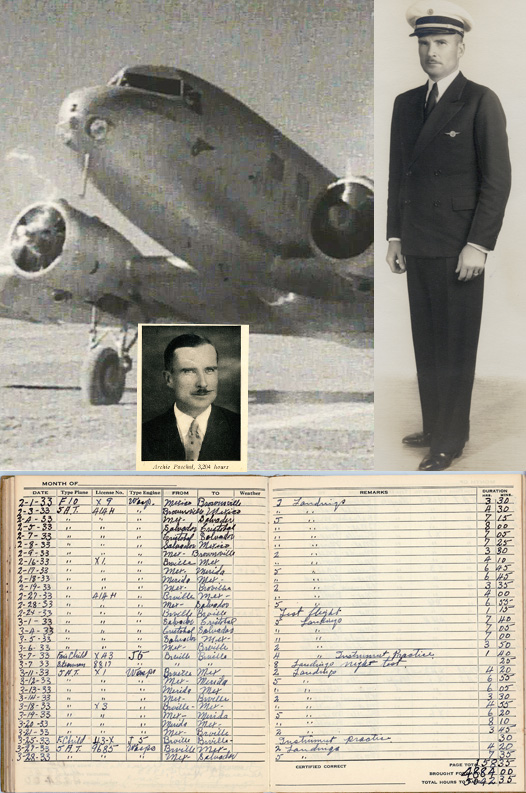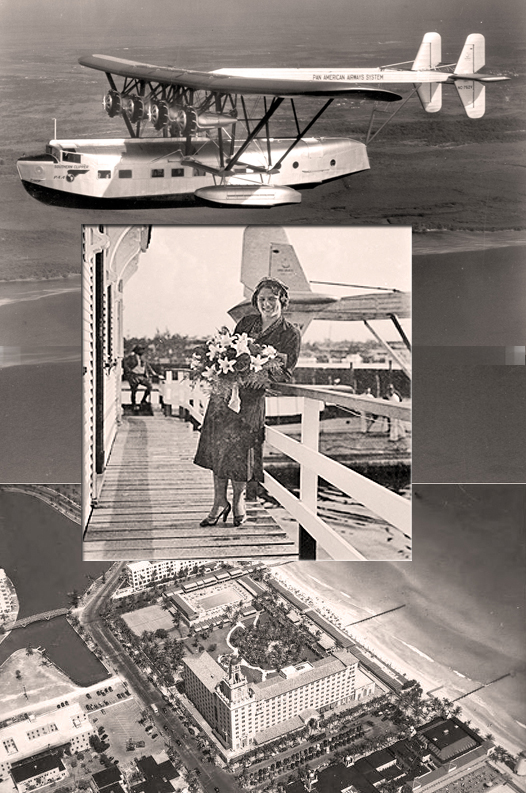MARCH 1933
Scroll down to read
Five March 1933 posts

MARCH 1, 1933
"Flying PAA’s Western Division"
DC-2 still (PAHF/Fulton Film Collection). Paschal official full-length portrait (Paschal Family Collection). Paschal PAA photo, March 1931, "Pan American Air Ways," p. 93 (PAHF Collection). Flight Log page (Paschal Family Collection).
Master Technical Sargent, Archie L. Paschal, an early U.S. Marine Corps enlisted aviator, retired in December 1929 after twenty years during which he amassed 2,300 flight hours in Europe the Caribbean and Central America and a chest full of medals including the Navy Cross. Archie then joined Pan American Airways.
By March 1933 Paschal was a senior pilot based in Brownsville, Texas, flying the company’s Central America routes. Shifting weather patterns, rugged mountainous terrain, high-altitude airports, and rudimentary navigation tools made Western Division routes among the system’s most treacherous.
Captain Paschal’s 81:07 flight hours in March 1933 included 2:10 hours of instrument practice and 25 minutes of night-landing practice, 71 landings in 6 aircraft from three manufacturers (Ford, Fairchild, Stearman). Paschal’s March 1933 workload was typical: 17 days on/14 days off/13 nights away from Beulah, his wife, and their sons, George (7 years), Archie, Jr. (5 years), and James (5 months). Archie’s month ended in Salvador, San Salvador on his way to Cristobal, Panama, having clocked 5,050:57 career flight hours.
His 1931-36 Pan Am flight logs confirm the importance of Pan Am’s monthly instrument training mandate. 75% of Archie’s Pan Am flights required “blind flying” -- 20 minutes to hours at a time. That experience and training came to naught, however; during an October 10, 1936 repositioning flight. When flying a DC-2 by instruments — NC14273, transferred from Mexicana to Panagra only a month earlier— Paschal hit a mountain northeast of Guatemala City, Guatemala, an area he knew thoroughly, killing the three-person cockpit crew. Pilot Archie Paschal was given a military burial at Arlington National Cemetery.
Sources:
A. Paschal Flight Log, Paschal Family Collection.

MARCH 9, 1933
"Engine Mechanics: Pan Am’s Unsung Heroes"
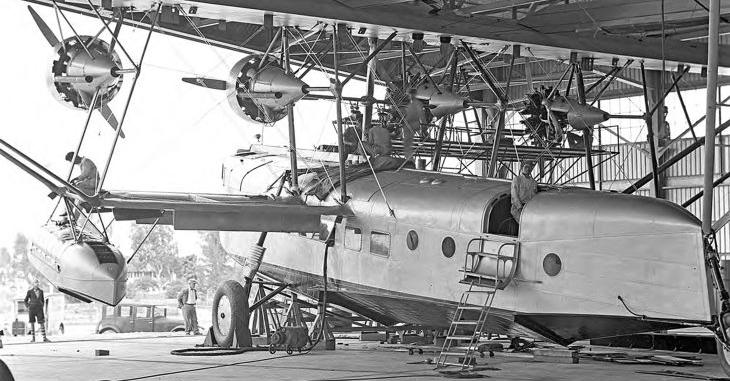
Photo: Clipper ship (S-40) in hangar for maintenance by Gleason Waite Romer, 07-11-1931.
Used with permission from Miami Dade Public Library. Helen Muir Florida Collection. Special Collections and Archives.
https://digitalcollections.mdpls.org/digital/collection/p17273coll3/id/12374/rec/111
Pan Am owned 107 aircraft in March 1933, and its Miami, FL, Brownsville, TX and Rio de Janeiro, Brazil maintenance shops ran nonstop, keeping engines in flying-shape. Based on PAA’s aircraft, the company owned approximately 500 Pratt & Whitney 9-cylinder engines: 420 Wasp; 80 Hornet.
"Aviation" magazine shared Pan Am’s 1933 engine maintenance schedule:
“On the long Canal Zone run... about fifteen hours flying time from Brownsville... 'long' servicing is given at Cristobal... (1) fill gasoline tanks; (2) check oil levels; (3) remove and inspect front spark plugs; (4) lubricate and inspect boxes for valve clearances, etc.; (5) remove and clean gasoline strainers; (6) check rear spark plugs for tightness; (7) check motor mounts; ( remove and lubricate push-rods and (9) clean engine thoroughly. On the return... to Brownsville... the following work is done. (1) change engine oil; (2) change spark plugs; (3) check magneto breakers for wear and clearance; (4) remove and clean carburetor jet plugs, and flush out carburetor; (5) remove and clean all gasoline and oil strainers. Any particular difficulties noted in flight by pilots are also taken care of.”
PAA required engine overhaul every 100 flight hours. Available data indicate that most aircraft flew 100 hours every 30-35 days, producing a continuous stream of engines headed to the machine shop. In his autobiography, "Flying the Oceans," Captain Horace Brock (PAA 1933-1954) writes that engine overhaul took two weeks: one devoted to disassembly, cleaning, inspection, parts refinishing or replacement; and one devoted to reassembly, inspection, testing and fine-tuning.
Source:
-Brock, Horace. "Flying the Oceans" (Steinhour Press, 1978), p. 46.

MARCH 17, 1933
"Miami Shamrocks"
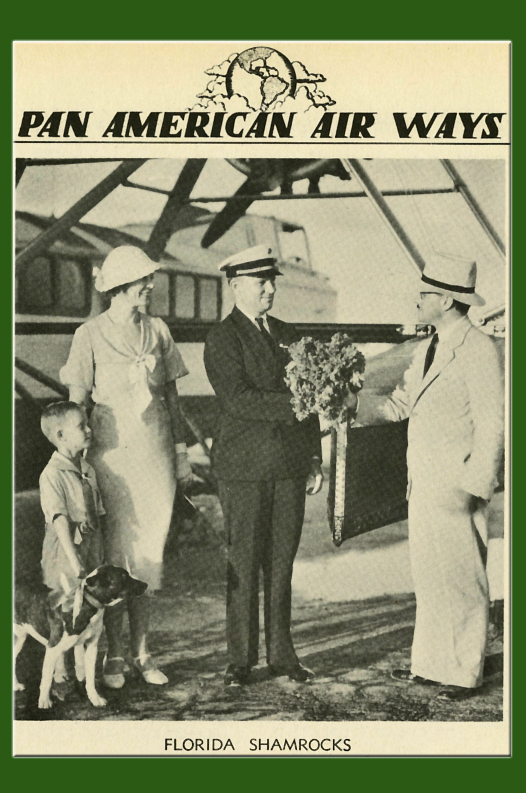
After flying the Consolidated Commodore to Miami from Kingston, Jamaica, Capt. R.O.D. Sullivan receives a bouquet of "Florida Shamrocks" in honor of St. Patrick's Day.
"Out from Kingston, Miami-bound on St. Patrick's day in the morning. Am flying seven green streamers, have seven green passengers, and a pair of green love birds in the express compartment. Plying over the emerald Caribbean and the Irish fields of Cuba."

MARCH 22, 1933
“I Danced All Night”
Ouida Calnek, "Miss Jamaica," and her whirlwind ambassadorial tour of Miami in 1933.
DATELINE: 4/2/1933, Kingston, Jamaica
Ouida Calnek stepped off Pan American Airway’s Southern Clipper (Sikorsky S-40 NC752V) at 6:00 p.m. onto the Bournmouth Bath landing barge where a gaggle of friends, reporters, and photographers welcomed her return from Miss Jamaica’s first ambassadorial trip. Responding to a Daily Gleaner reporter’s question about her weekend in Miami, Ouida stated that she had “Not one hour’s sleep since taking off Friday morning.”
Ms. Calnek had left Kingston Friday at 8:00 a.m. on Pam Am’s dime and aboard its Consolidated Commodore NC670M. Met by flower-toting fans at Cienfuegos and Havana, Cuba, Ouida arrived in Miami at 5:45 p.m. where Miami City Manager, L.L. Lee greeted her as the city’s official guest and Pan Am announced her presence as its honored guest at that night’s Aviation Ball, the “brilliant event of the spring social season.”
Following a photo session, Ouida was hustled up Biscayne Bay Boulevard to the Robert Clay Hotel to unpack, change into evening wear, then travel across Biscayne Bay to the palatial Roney Plaza Hotel for the evening’s soirée. She entered the Roney Hotel’s twelve-acre Palm Garden at 9:30 p.m. and greeted military, industry, and society notables. Aviation dignitaries included an Admiral, Brigadier General, assorted Navy and Army aviators, Pan Am’s favorite aircraft designer, Igor Sikorsky, Pan Am executives and Chief Pilot Edwin “Ed” Musick. The night’s festivities -- fireworks, Navy and Army formation flyovers, music, dancing -- kept Miss Calnek from her room until 5:00 a.m. Saturday morning.
Miss Jamaica’s Saturday started at 8:00 a.m. with a city tour, a luncheon, a movie, a formal dinner, and ended when Miami’s nightclubs closed at 3:00 a.m. Ms. Calnek’s wake-up call for her 8:45 a.m. flight home came much too early Sunday and less-chipper than on Friday afternoon, she posed for photos on the Dinner Key barge before boarding the "Southern Clipper" for Kingston… and, a long sleep.
Sources:
•"The Daily Gleaner," Kingston, Jamaica, Mon. 4/3/33, p.3.
•"Pan American Air Ways," Vol 4, No.2, p. 4.University of Miami Special Collections https://digitalcollections.library.miami.edu/digital/collection/asm0341/id/41085/rec/2
Photomontage:
•Pan American S-40 "Southern Clipper" (PAHF Collection).
•Pan American Airways: Miss Ouida Calnek, Miss Jamaica of Kingston. Jamaica. 3-31-33.
(Miami-Dade Public Library System. Gleason Waite Romer Photos).
•Miami Beach from the Air: Roney Plaza Hotel, as seen from over Collins Park 4-1937.(Miami-Dade Public Library System.Gleason Waite Romer Photos).

MARCH 29, 1933
“Pan Am Enters China”
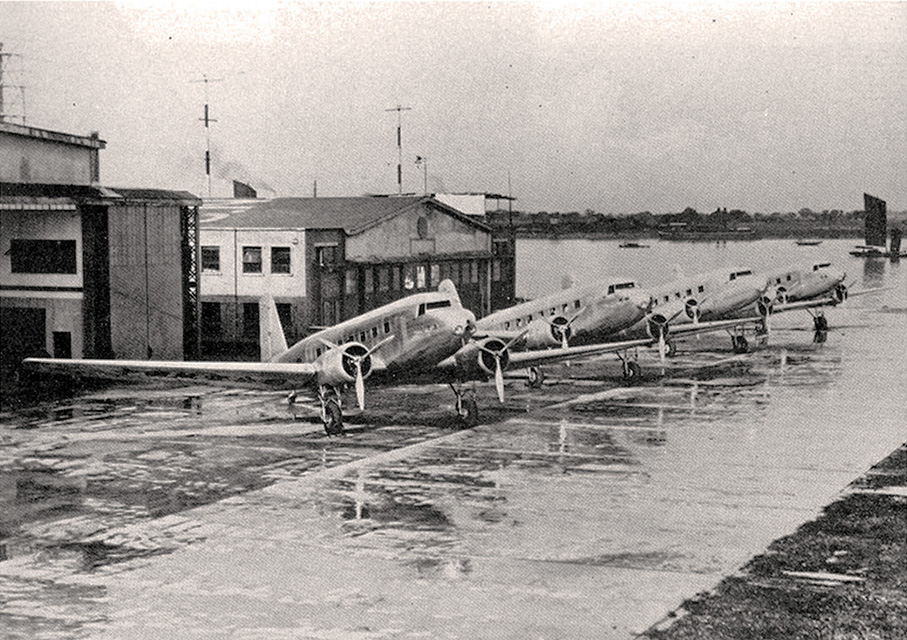 Four DC-2s of Pan Am Affiliate, China National Aviation Corporation (CNAC)
Four DC-2s of Pan Am Affiliate, China National Aviation Corporation (CNAC)
Pan American Airways president, Juan Trippe, sent Vice President Harold Bixby to Shanghai to find a China-toehold as he planned for transpacific service. To do so, Bixby replicated PAA’s Central and South America entrance model: acquire a national airline -- in part or whole -- thus become a domestic carrier while not violating countries’ limits on foreign ownership of key industries.
China didn’t know Trippe was negotiating in New York to buy Curtiss-Wright Corporation’s money-losing minority stake in China National Aviation Corporation (CNAC). CNAC ownership was split 55/45 percent between China’s government and Chinese Airways Federal, a Curtiss-Wright shell company nestled inside its Intercontinental Aviation Corporation.
Six weeks after Bixby landed in China, Pan Am leveraged Bixby’s on-the-ground assessments to buy Intercontinental Aviation Corporation for $181,385 on March 31/April 1, 1933 (International Dateline differences make such a head-scratcher dual-sale-date possible). That purchase netted few physical assets: an airport hanger and 45% of CNAC stock, the deal’s unstated target.
China’s government was apoplectic claiming the sale violated CNAC’s charter stipulation that no CNAC stock could be sold without mutual agreement between Curtiss-Wright Corporation and China. In China’s Wings, historian Gregory Crouch admits the sale “was legally dubious … without violating the letter of the contract” because not a single share of CNAC stock was “sold.” Money changed hands for a company whose assets included CNAC stock. It was a legal, albeit “crafty, shades-of-gray takeover.”
For more on this story see:
•Gregory Crouch, “China’s Wings.” Bantam, 2012. https://www.amazon.com/Chinas-Wings-Intrigue-Romance-Adventure/dp/0553804278
•Eric Hobson, “Mission to China," Parts 1-4, Pan Am Historical Foundation, https://www.panam.org/explorations/743-paa-s-mission-to-china

Go back to "90 Years Ago" main page

